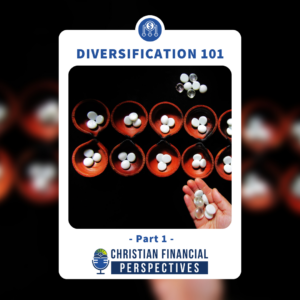Click below to listen to Episode 138 – Diversification 101: Part 1 – Style Charts
Subscribe: Apple Podcasts | Google Podcasts | Spotify | Amazon Music | Stitcher | RSS | More
Diversification 101: Part 1 – Style Charts
This may be one of our most important podcast series to date. Diversification is a significant part of investing, and in this episode, Bob and Shawn discuss the different equity and fixed-income charts. This is a great episode series for learning the basic ins and outs of diversification within investing. Bob and Shawn also share what they go through daily to help make sure their clients’ portfolios are appropriately diversified.
On top of offering diversified investment portfolios, Christian Financial Advisors also adds both faith-based investing and biblically responsible investing aspects to our clients’ portfolios. Sit back and take a peek at how our firm works when creating a diversified investment portfolio within a Biblical worldview.
HOSTED BY: Bob Barber, CWS®, CKA®
CO-HOST: Shawn Peters
Mentioned In This Episode
Bible Verses In This Episode
ECCLESIASTES 11:2
Invest in seven ventures, yes, in eight; you do not know what disaster may come upon the land.
Want to ask a question about your specific situation? Schedule a complimentary 15 minute phone call.
EPISODE TRANSCRIPT
Intro:
Welcome to Christian Financial Perspectives, where you’re invited to gain insight, wisdom, and knowledge about how Christians integrate their faith, life, and finances with a biblical worldview. Here’s your Christian Financial Advisors’ host, Bob Barber and his co-host, Shawn Peters.
Shawn:
Welcome to another episode of Christian Financial Perspectives. We’re so glad you’re joining us today. We’re gonna be covering part one of a three part series on diversifying your investments. And if you like this kind of content on how to diversify your investments, how to invest from a Biblical perspective or just other topics on how Christians can integrate faith with their finance, then be sure to subscribe to our channel. Click that link below as well as if you’d like this particular video, be sure to give us a thumbs up and smash that like button. So, Bob, why don’t you get us started on part one today.
Bob:
So we’re gonna start on part one, like we said, of a three part series. It’s gonna be a lot. And it’s called Diversification 101. The three part series, today, we’re going to talk about understanding the different equity and fixed income style charts. Okay? And then next week we’re gonna be talking about understanding the 12 sectors and industries of diversification. Then the last part, part three, is going to be about setting up asset allocation models using all of this information. So, this is a good series for the DIY, the do-it-yourself investor, but at the same time, it also lets our audience know what we go through to build our portfolios that are biblically responsible. Because after you go through all of this, then you have to overlay the biblically responsible part on it, which looks for the positive and takes and takes away the negative.
Shawn:
That’s right. So effectively after going through all three parts of this series, if you’re investing on your own, this will be a really good introduction to everything that goes into the diversification. And if you’re a client of ours, or if you’re someone who after watching some of our videos, you like what we’re doing and you maybe wanna become a client. And either way, it just kind of gives you a little bit of, I guess, kind of peeking under the hood. What are some of the things that we have to go through? And then, like you said, and then on top of that, we also do the faith-based part of it, where as a biblical responsible investing firm, we have to look for those positive and negative screens after we’ve already done all this other stuff.
Bob:
And something exciting. We’re gonna be introducing something very exciting as we talk about this series and we’re calling that…
Shawn:
Well let me go over that. Before we get into part one, we are excited to offer a new service, and it’s gonna allow investors of any size to utilize our biblically responsible investing portfolios. And we’re gonna be calling it Tier Genesis. And this new service, it’s gonna allow our team to offer an all digital process for opening new accounts and intelligent portfolio rebalancing. All of the accounts will be actively managed throughout the year using Biblically responsible investing just as we’ve always done. But this allows us to waive our previous minimum of $100,000 per household, as well as to serve people who are more of a, “Don’t call me, I’ll call you”, the DIY investors of any size. I mean, you might be a larger client and just prefer a system that’s a little more digital. And look, if I need you, I’ll call you. So yeah, we’re very excited about that. If you’d like to learn more about it or you’re ready to get started, just visit tiergenesis.com. All right.
Bob:
I want to ask Garrett, if you’ll put that up on when we say that, put that Tier Genesis up there.
Shawn:
And we’ll have it in description, too. We’ll make sure it’s in the description.
Bob:
Okay. So today, in the first part, we’re gonna talk about the equity style chart and understanding that chart and how that’s used in diversification. And then the fixed income style chart. Now, Garrett’s gonna put it up here for us a diagram of what we use for the equity style chart. It looks like a tic-tac-toe.
Shawn:
Before you go a little further. Just in case. We may have a wide range of viewers and listeners, but…
Bob:
What is equity?
Shawn:
But first, for those of you who aren’t aware, equity would also be another name for, say, stocks and then for your fixed income, that’s typically referred to as bonds. So just kind of depending on where you’re coming from. just wanna make sure we cover that real quick.
Bob:
So as you’re looking at this equity style botch, which is what we’re gonna cover first, you notice that there’s nine different blocks. Like you said, it’s very much like a tic-tac-toe board.
Shawn:
Yeah. Kinda reminds me of that thing too, in school where you do the real basics of what eye color is someone gonna have and how you show the different genes with…
Bob:
I don’t remember that, Shawn
Shawn:
It’s the thing about the dominant versus recessive genes. So, it looks very much like that for anybody, any science nerds on here.
Bob:
So you notice across the top where it says a “value blend and growth”, and that has to do with the style of the stock you’re wanting to go in and a price to earning ratio. Is it trading at a great value or is it a growth stock? The PE ratio, priced to earn ratio, is gonna be higher. So it’s a higher risk, but also could be a lot more growth. So. we’re gonna get into that deeply, but right now we’re just talking about value blend and growth. And then you have, where there’s a large, small, or mid-size company, Shawn, when I first got into the business, the large was three billion and up.
Shawn:
Oh wow.
Bob:
Okay. Now, it’s 10 billion and up. A mid-size company is gonna be between 2 [billion] and 10 [billion], and the small is between 300 million and 2 billion. So, when you’re building a equity portfolio, a stock portfolio, you want to diversify in all of these different blocks.
Shawn:
So for an example, Bob, for the value versus growth, it’ll be a little harder to find one that’s right there in the middle for the blend, off the top of my head. But for a value, you might look at something like – and again, this is not an endorsement of anybody, it’s just big names people might recognize as they’re listening. But you might have a company like Exxon that might be considered more of a value, right?
Bob:
It’s definitely large cap, and it could be and but it depend on where it’s trading at.
Shawn:
It depends. Right, right. I just mean in general. It’s a large company.
Bob:
But it definitely was a value a year and a half ago.
Shawn:
That’s right.
Bob:
But today, the way it’s way up there, it could pop over into that growth, so it can go back and forth.
Shawn:
Well then, yeah, so again, I know it depends, I’m just trying to kind of paint a picture here. So you got the really large company that maybe there’s not a whole lot of growth, but they’re paying consistent dividends. That’s if they’re in that value space.
Bob:
That would be considered large cap value.
Shawn:
And then on the growth side for the most part, Tesla has been very much like a growth, because their PE is really high. And so just as an example, people might recognize the names.
Bob:
That’s good. And this is no endorsement to go buy a Tesla.
Shawn:
Yes. It’s not an endorsement, it’s just, I figured, hey, let’s throw some household names out there that people might recognize.
Bob:
Us, too. We have to deal with compliance, so we wanna make sure that we’re complying with everything.
Shawn:
Not a recommendation.
Bob:
So again, the large cap stocks are those with a $10 billion. That’s with a B. The mid-cap is 2 to 10 [billion]. And the small cap is 300 million. And growth stocks are categorized by their above average increase in revenue and earnings. So they’re growing; they’re in their growth stage.
Shawn:
A lot of your tech stocks would be considered growth.
Bob:
Yeah. That’s true.
Shawn:
Usually it’s stuff coming put of Silicon Valley. It is like, oh, it’s very much growth.
Bob:
Yeah. The PE ratio on these, or price to earning ratio, can be 50, 60, 70 and above. So, it’s a multiple. If you go to any of the financial websites, you can pull it up and you can look at the PE ratio, price to earning ratio. Where on the value side of it, you’re gonna get that PE ratio of like 20 and under, 15 and under. So, it’s trading at a value. It’d be like real estate’s gonna become a good value next year. Well, as we’re making it, this is gonna be coming out in 2023, and I think real estate is really gonna become a good buy if you’re patient.
Shawn:
That’s right. So to compare some of those numbers, your market average for the PE, the price to earnings ratio, typically around like 2025. So that’s why the value at say 15, 10 to 15, it’s gonna be below the market average, and your growth is well above that average.
Bob:
Now, just to get back to that equity style chart, I remember when the Timothy Plan started off as a Christian based mutual fund. All they had was a small cap value fund. That was it, and then they had a bond fund. Well, now they’ve got all these different sectors and actually their largest funds are their large cap value.
Shawn:
It’s actually, as kind of a side note on the Biblically responsible side of things, it’s really encouraging to see that there are more and more options to invest with your values as a Christian. As opposed to like when you first started, it was a lot harder.
Bob:
It was very limited. Very, very limited. Now the blend part, as you see that, that’s going to be something like, just think of the S&P 500, the S&P 500 index fund. That’s going to hang out right in the middle because it’s gonna have your growth. The Fortune 500, it’s gonna have your growth in there, and it’s going to have your value. So there’s your blends, and you can have a blended investment right down the middle of that chart. Then we get to the fixed income style chart. And you can see here how this is broken down is by short term bonds.
Shawn:
This is across the top.
Bob:
Yep. Short term bonds, one to five years, even some that can be three months. Intermediate term bonds and long-term bonds. Now the longer the term of the bond, the better or worse it can do, depending on what interest rates are doing.
Shawn:
That’s right. Depending on which way the interest rates are going.
Bob:
So, long-term bonds have gotten hit very hard this year. I mean, the year 2022 because interest rates have continued to go up.
Shawn:
Right. And if you’re not aware, for those watching and listening, is that when your interest rate goes up, the price of the bonds go down and vice versa, which is why those longer term bonds can be affected more. Because when you have an interest rate environment that’s increasing, which the Fed has definitely been doing a lot of. So it’s gonna obviously make the price, the average price of those longer term bonds, go down more.
Bob:
If you don’t hold them to maturity. So, that’s how the price fluctuates. So think about this, this last year in 2022, interest rates have gone up more than more than 2%. You have a 15 year bond, it’s called bond duration. So, you take 15, multiply that times two. That’s how much those bonds have gone down in value – 30%. Now, if you have a one year bond and interest rates go up by two, it only goes down 2%. Technically. I mean that’s what the math says.
Shawn:
Just a real simple mathematic formula. That’s right.
Bob:
So, you have your short, your intermediate, and your long term, and then you have your high quality, your low quality, we call that high yield, or we don’t call it junk bonds, but it kind of is. But we use the term high yield instead.
Shawn:
Well, high yield sounds better than junk bonds, right?
Bob:
Yeah, it does. It does. So your high quality, that’s gonna be your AAA rated, AA rated type bonds, your very well known companies that are issuing debt.
Shawn:
Or like US treasuries, things like that, right?
Bob:
Because there’s all kinds of different bonds. There’s corporate bonds. There’s municipal bonds. There’s government bonds. There’s school bonds. We’re in an area where it’s growing so fast that there’s been a lot of school bonds issued and it’s backed up by the strength of our county and our city and the taxing strength. So those could be very high rated, good quality, depending on where they are. So there’s bond funds and there’s individual bonds. And bond funds are gonna fluctuate. And you don’t have a lot, you can’t do a lot about it, but if you’re buying the individual bonds and it fluctuates, don’t worry about it.
Shawn:
Exactly. And that’s one thing to think about, especially if you’re listening to this to to do-it-yourself is that if you buy a bond fund, it’s a lot more susceptible to that price fluctuation.
Bob:
That’s correct.
Shawn:
Because there isn’t really a set maturity date because you’re buying a fund that buys bonds, whereas if you do purchase those fixed income positions, those bonds directly, that kind of gives you a little bit more of an advantage because the price will still fluctuate. But if it’s a five year bond, and you just make sure to hold it to maturity, it doesn’t really matter as much that the price fluctuated in between.
Bob:
Now, you’ll be rewarded or you get rewarded for going lower quality. They normally pay a higher interest rate, but there’s also a greater risk of default. Then your mids gonna fall right in there. And then your high quality bonds, they’re gonna have your lowest interest rates, but they’re also gonna have a very low risk default, because they’re, like you say, they’re highly, highly rated. So that gets us to, for today, on part one, as you’ve got your equity style chart, your fixed income style chart. Now, this is just the beginning of this, because then you’ve gotta look at your regions and your countries. You’ve gotta look at the developed countries versus the emerging countries. The developed countries are like Japan, United Kingdom, Canada, Switzerland, France, Australia, Germany, South Korea, Netherlands, and Sweden. We got it right here. And then the emerging markets, even though they’re big, like China’s huge, that’s considered an emerging market, because it’s still emerging – India, Taiwan, Brazil, South Africa, Thailand, Mexico, Indonesia, Malaysia, and Turkey. So you got all these both charts, and then you have all these…
Shawn:
And then on top of that, Bob, like you kind of alluded to earlier, like say on the fixed income side, you not only have the short, intermediate, and long term like for your duration, and then you have your high, medium, and low quality. But then you also have, well, is it government, like federal? Is it other countries, but do you have federal, is it considered municipal? Is it a corporate bond? Is it a school bond? Like, I mean, there’s all those other kind of subcategories to this. But this is just, I guess you’d say, more of a high level.
Bob:
We’re starting with basic, and we’re gonna go deeper. Because next week we’re gonna have part two of understanding the 12 sectors, and all of these sectors go within one of these categories.
Shawn:
That’s right.
Bob:
Yeah. And we’re gonna cover all the sectors like health. I’m not gonna list all 12, but here’s a few: healthcare, communications, technology, consumer staples, energy, real estate, plus many others. And we’re going to not only get into those sectors, but we’re gonna go under each sector or sub-sectors. Like healthcare, there’s gonna be the hospitals, but then there might be biotechnology where technology, there’s all the different types of technology that come into that real estate. It can be industrial real estate, it can be commercial, and it could be residential. So there’s all the different types of real estate.
Shawn:
And then once we’ve gone through all of that, then our part 3 will be covering the building asset allocation models.
Bob:
And you take all this information and put it together. So we’re gonna teach the DIY if they want to go this deep. And if you don’t want to, like we said at the beginning, we’re coming out with our Tier Genesis for the DIY investor that can just go online and open up an account, and all this research and active management is done for you, knowing we’re overweighting or underweighting constantly and looking at what the markets are going.
Shawn:
We trade throughout the year. We’re not day trading, but we trade many times throughout the year.
Bob:
We don’t just buy and holding= sales.
Shawn:
Exactly. Well, thank you so much for joining us. God bless and I hope to see you in part two.
Outro:
We invite you to listen to all of our past episodes, covering many financial topics from a Christian perspective. To make sure you don’t miss any of Bob’s upcoming episodes. You can subscribe to Christian Financial Perspectives on iTunes, Google Podcasts, Spotify, Stitcher, or Amazon Music to learn more about integrating your faith with your finances. Visit Christianfinancialadvisors.com or call (830) 609-6986.
Disclosure:
Investment advisory services offered through Christian Investment Advisors, Inc DBA Christian Financial Advisors also known as Christian Financial Advisors Management Group, a registered investment advisor. Comments from today’s show for informational purposes only, and not to be considered investment advice or recommendations to buy or sell any company that may have been mentioned or discussed. The opinions expressed are solely those of the host Bob Barber and his guests. Bob does not provide tax advice and encourages you to seek guidance from a tax professional. While Christian Investment Advisors believes the information to be accurate and reliable, we do not claim or have responsibility for its completeness, accuracy, or reliability.












